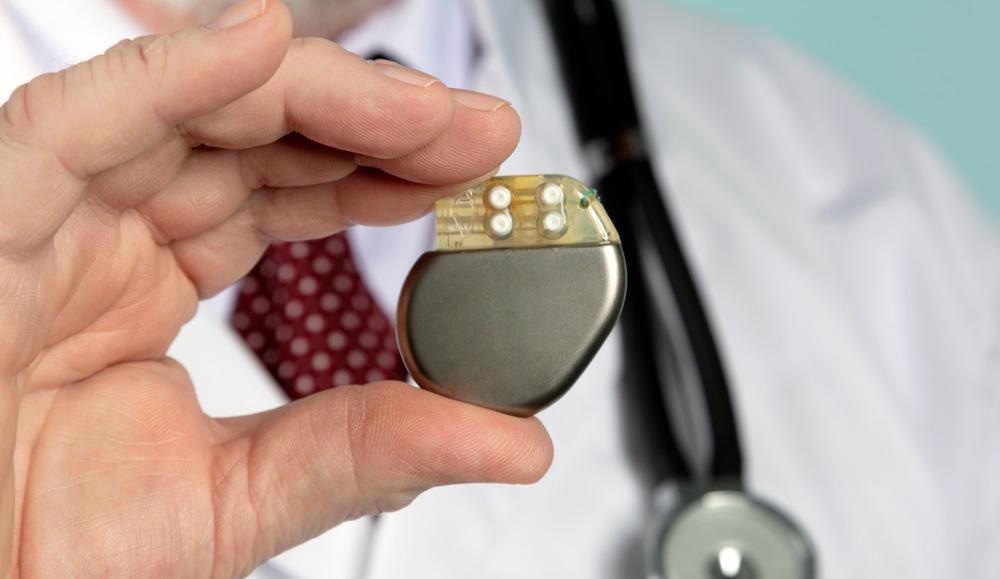Tel Aviv University scientists have developed a new material that will enable pacemakers to charge using only the heartbeat, with no need for batteries. As well as immediate medical applications, researchers believe this piezoelectric material could also have a wider impact on clean technology.

Image Credit: Birgit Reitz-Hofmann/Shutterstock.com
The innovative new material is environmentally friendly, entirely biological, and non-toxic. It causes no harm to the tissues inside the body, making it an ideal candidate for medical uses.
The material is also highly flexible and as strong as titanium. It is similar to collagen, the main structural protein found in mammals’ connective tissues.
As a piezoelectric material, it generates electric current and voltage from mechanical stress. Placed inside the body, it can generate current from the natural mechanical processes of internal organs such as the heart.
Taking a Cue from Collagen
Researchers explained that collagen makes up about 30% of all proteins in the body. It has a helical structure, mechanical strength, and high flexibility.
However, collagen molecules are large and complicated – making them difficult to synthesize. Researchers, therefore, looked for a smaller, shorter, and simpler molecule based on collagen with similar characteristics.
In 2019, the team published a study in Nature Materials that demonstrated its use of nanotechnology techniques to create a new biological material that met the requirements for a collagen clone.
The material is known as tripeptide, a short molecule called Hyp-Phe-Phe that is made up of only three amino acids. It is capable of simple self-assembly by forming a helical structure like collagen. The material exhibits similar strength and flexibility properties as collagen.
In its latest research, the team investigated whether or not the new material was piezoelectric. Piezoelectricity enables some materials to generate electric currents from the application of mechanical stress – or vice versa.
Using Nanotechnology to Develop New Materials
Researchers made nanometric structures from the new material for their study using advanced nanotechnology tools. Nanotechnology techniques were also used to apply mechanical pressure to the minuscule structures.
Their experiment demonstrated that the new material is in fact piezoelectric. They found that it exhibited some of the highest levels of piezoelectric ability ever discovered, better than materials commonly used today.
Currently available piezoelectric materials typically contain lead, making them inappropriate for medical use.
Applications for the New Material
Discovering these high levels of piezoelectric abilities was incredibly significant and has ramifications beyond the immediate medical application. Technologists can now create minuscule motors for small devices that do not require any external power input such as a battery.
Researchers will apply crystallography and computational quantum mechanical methods to better understand the piezoelectric behavior exhibited by the material. This will enable better engineering of crystals that can be used to build medical devices.
Harnessing mechanical energy in the body and converting it into electricity would make it possible to produce medical devices such as pacemakers that have no requirement for a battery – and no risky surgery to replace it.
Developing the new material’s medical applications is the priority for the researchers. However, they believe that their environmentally friendly, non-toxic, biological piezoelectric material can also have applications beyond medicine.
Researchers hope that the material could be used to replace current piezoelectric materials that contain lead, reducing the risk of toxic pollution.
References and Further Reading
Santu Bera et al. (2021) Molecular Engineering of Piezoelectricity in Collagen-Mimicking Peptide Assemblies. Nature Communications. [Online] https://doi.org/10.1038/s41467-021-22895-6.
Santu Bera et al. (2019). “Rigid Helical-Like Assemblies from a Self-Aggregating Tripeptide.” Nature Materials. [Online] https://doi.org/10.1038/s41563-019-0343-2.
Tel-Aviv University (2021) New Nanotech will Enable a 'Healthy' Electric Current Production Inside the Human Body, Researchers Report. ScienceDaily. [Online] www.sciencedaily.com/releases/2021/07/210706133124.htm.
Disclaimer: The views expressed here are those of the author expressed in their private capacity and do not necessarily represent the views of AZoM.com Limited T/A AZoNetwork the owner and operator of this website. This disclaimer forms part of the Terms and conditions of use of this website.